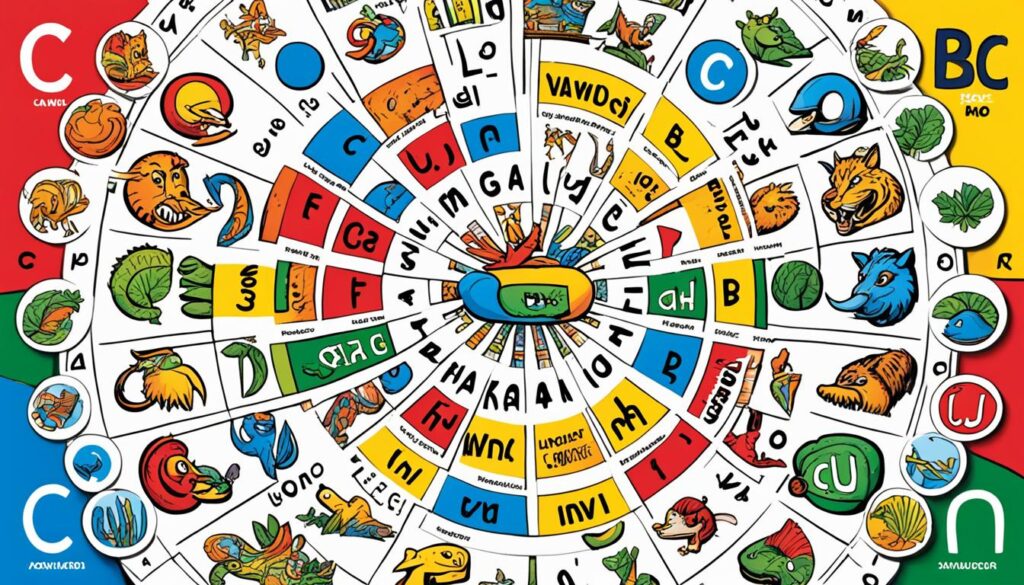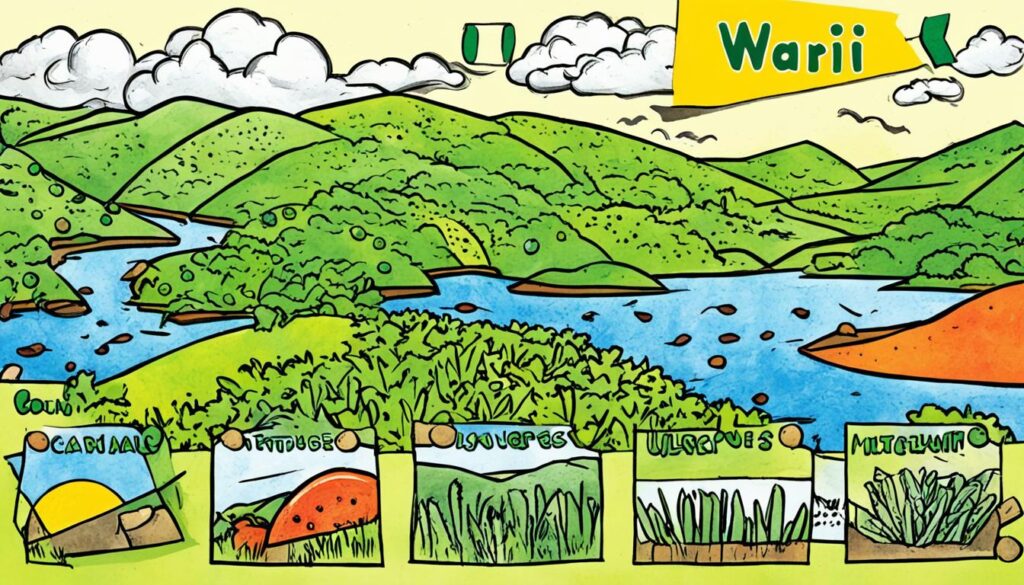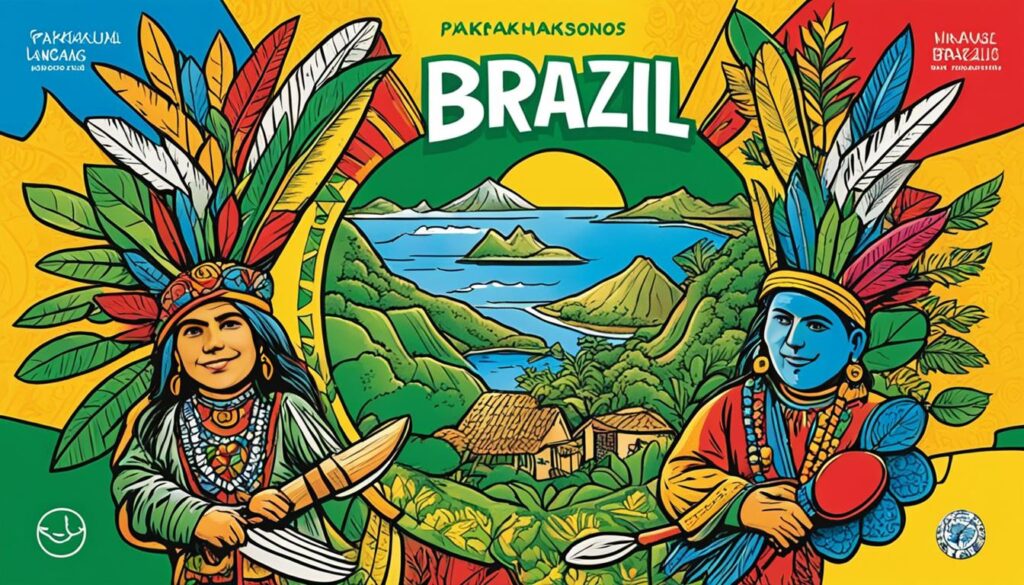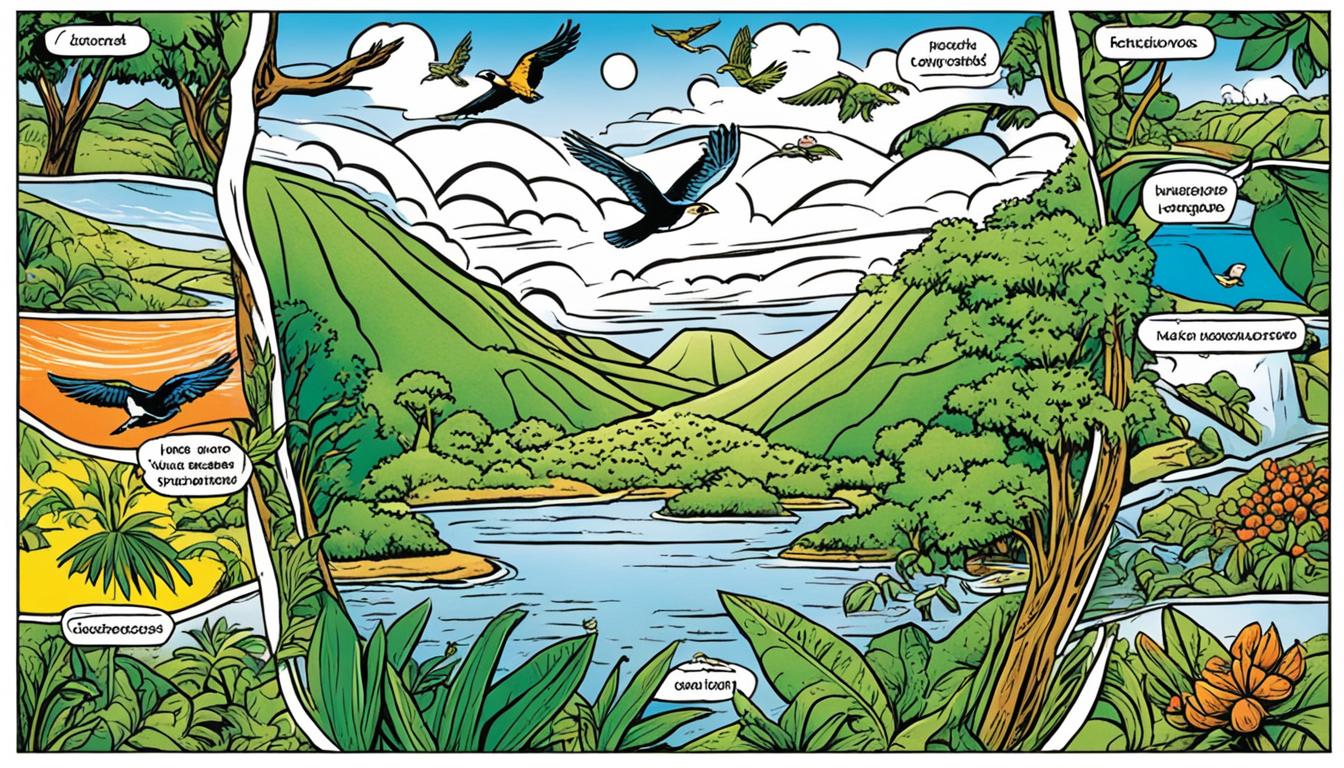Did you know that the Pakaásnovos language, also known as Wari or Oro Wari, is an endangered indigenous language spoken by the Wari people in Brazil? With approximately 2,700 native speakers, this unique language is a part of Brazil’s linguistic diversity and plays a vital role in the preservation of indigenous culture.
In this article, we will explore the fascinating aspects of the Pakaásnovos language, including its linguistic features, cultural significance, and the efforts being made to document and revitalize it. Join us on this journey to discover the beauty and importance of this endangered language in Brazil.
Language Family and Dialects
The Wari language belongs to the Chapacuran language family, which is primarily spoken in the border region of Brazil and Bolivia within the Amazon rainforest.
The Wari language, also known as Wari’ or Oro Wari, is the sole remaining vibrant language of the Chapacuran language family. It has about 2,700 native speakers and is primarily spoken in seven villages along the tributaries of the Pacaas Novos river in Western Brazil.
Within the Wari language, there are several dialects that may vary in terms of pronunciation and vocabulary. These dialects include the Northern dialects, which consist of Wari’-Oro Waram, Wari’-Oro Mon, and Wari’-Oro Waram Xijen. The Southern dialects consist of Wari’-Oro Não, Wari’-Oro Eo, Wari’-Oro At, Wari’-Oro Jowin, and Wari’-Oro Kao Oro Aje.
Comparison between Northern and Southern dialects:
| Northern Dialects | Southern Dialects |
|---|---|
| Wari’-Oro Waram | Wari’-Oro Não |
| Wari’-Oro Mon | Wari’-Oro Eo |
| Wari’-Oro Waram Xijen | Wari’-Oro At |
| Wari’-Oro Jowin | |
| Wari’-Oro Kao Oro Aje |
The Wari language family has a diverse range of dialects, each with its own unique characteristics. These dialects play a significant role in preserving the linguistic heritage of the Wari people and contribute to the overall linguistic diversity of the Chapacuran language family.
Phonology
The Wari language, also known as Oro Wari, exhibits a unique phonological system with a diverse range of consonant phonemes. These include bilabial, dental, post-alveolar, velar, and glottal sounds. Interestingly, Wari possesses a rare trilled affricate sound (/t͡ʙ̥/) that is found in only a few other languages.
| Consonants | Bilabial | Dental | Post-Alveolar | Velar | Glottal |
|---|---|---|---|---|---|
| Voiceless Stops | p | t | ch | k | |
| Voiceless Fricatives | s, sh | h | |||
| Nasals | m | n, nh | |||
| Trills | r | ||||
| Approximants | w | y |
When it comes to vowels, the Wari language exhibits an asymmetrical vowel system with a notable emphasis on close and close-mid front vowels. The vowel inventory includes sounds such as /i/, /e/, /ɛ/, /a/, and /o/. These vowels play a crucial role in shaping the pronunciation and meaning of Wari words.
The Wari language follows a syllable structure of CV(C), where C represents a consonant and V represents a vowel. Consonant clusters are relatively rare in Wari, as the language tends to prefer single consonant sounds in syllables.
Stress placement in Wari is consistent, as it typically falls on the final syllable of words, particularly in major lexical categories. This stress pattern has important implications for the rhythm and intonation of the language.

Unique Trilled Affricate Sound
The Wari language showcases a distinctive trilled affricate sound (/t͡ʙ̥/), which sets it apart from many other languages. The presence of this unique phoneme adds to the linguistic richness and complexity of the Wari language.
Morphology and Possession
The Wari language is an analytic language with minimal verbal inflection. However, it incorporates various derivation processes to express different meanings. In terms of possession, the Wari language uses different strategies for xiʼ nouns and non-xiʼ nouns.
Xiʼ nouns in the Wari language are inalienably possessed and are marked with possession marking suffixes. These suffixes indicate the possessor and establish a paradigm of possessive relationships. Here is an example of a possessive marking suffix for a xiʼ noun:
Xiʼ noun: morokxiʼ (‘my house’)
In contrast, non-xiʼ nouns in the Wari language use nominal inflectional clitics to indicate possession. These clitics attach to the noun and show the possessor. Here is an example of a nominal inflectional clitic for a non-xiʼ noun:
Non-xiʼ noun: wahinan (‘his/her hand’)
Additionally, the Wari language also employs reduplication for aspect marking in certain contexts. Reduplication involves repeating a portion of a word to indicate a specific aspect or action. This adds another layer of complexity to the morphology of the language.
A Table comparing possession marking strategies in the Wari language:
| Xiʼ Nouns | Non-xiʼ Nouns |
|---|---|
| morokxiʼ (‘my house’) | wahinan (‘his/her hand’) |
| huwatxiʼ (‘your house’) | nawohin (‘our hand’) |
| pakaxiʼ (‘his/her house’) | sabainan (‘their hand’) |
Numeral Concepts
The Wari language, also known as Oro Wari, has a unique way of expressing numeral concepts. Unlike many other languages that have specific numeral words, the Wari language conveys numerals through verbs. Each verb represents a specific numeral concept, allowing speakers to express quantities in a distinct and meaningful way.
For example, the Wari verb xica’ pe signifies the concept of ‘being alone.’ Instead of saying the numeral ‘one,’ Wari speakers use this verb to convey the idea of singularity or being by oneself.
Similarly, the verb tucu caracan represents the concept of ‘facing each other.’ Rather than using a word for ‘two,’ Wari speakers use this verb to capture the notion of two entities looking at each other or being in a face-to-face position.
This unique approach to numeral concepts in the Wari language reflects the language’s reliance on verbs to express various aspects of quantity and numeracy. It showcases how language can shape our perception and understanding of numbers, offering a fascinating insight into the linguistic and cultural characteristics of the Wari people.

Language Documentation and Endangerment
The Pakaasnovos language, also known as Wari, is currently classified as an endangered language. Out of the total ethnic population of approximately 4,400, there are only around 2,400 speakers remaining. This decline in speakers poses a significant threat to the preservation of the Pakaasnovos language and its cultural heritage.
Recognizing the urgent need to document and preserve this endangered language, various linguistic research and documentation projects have been initiated. These projects aim to create a comprehensive record of the Pakaasnovos language, including its grammar, vocabulary, and syntactic structures. Language documentation is crucial as it enables future generations to study and revitalize the Pakaasnovos language.
Efforts in language documentation involve close collaboration with native speakers, educators, linguists, and community organizations. These partnerships ensure that the documentation process respects the cultural and historical context of the Pakaasnovos people while also capturing the linguistic nuances and subtleties of the language.
One of the primary objectives of language documentation is to raise awareness about the endangered status of the Pakaasnovos language. By disseminating information about this linguistic preservation effort, it is hoped that policymakers, researchers, and the wider public will take action to support language revitalization initiatives.
“Preserving endangered languages like Pakaasnovos is not just about the linguistic aspect. It is also about preserving the unique cultural heritage and wisdom embedded within these languages. Language documentation acts as a means of safeguarding the rich diversity of human expression and thought.”
Language documentation projects involve recording oral narratives, songs, and traditional knowledge passed down through generations within the Pakaasnovos community. These recordings not only capture the linguistic aspects of the language but also provide insights into the cultural practices, beliefs, and values of the Pakaasnovos people.
The linguistic preservation efforts pertaining to the Pakaasnovos language are part of a broader commitment to supporting and revitalizing endangered languages worldwide. Through language documentation, indigenous languages are given the opportunity to thrive and reclaim their rightful place in the cultural tapestry of societies.
The Importance of Language Documentation:
- Preserves linguistic diversity
- Captures cultural heritage
- Enables language revitalization
- Raises awareness about endangered languages
- Fosters intergenerational transmission of knowledge
Language documentation is not only a means of preserving the Pakaasnovos language but also an act of honoring and valuing the cultural identity of the Pakaasnovos community. Efforts in language documentation pave the way for future generations to connect with their ancestral roots and contribute to the ongoing vitality of indigenous languages.
Cultural Significance and Indigenous Heritage
The Pakaasnovos language holds great cultural significance as it is an integral part of the indigenous culture and heritage of Brazil. The language represents the linguistic diversity of the country and is deeply interconnected with the rich cultural traditions of the Pakaasnovos people. Its preservation is crucial for maintaining the unique identity and cultural heritage of this indigenous community.
“Language is not just a tool for communication; it is the heart and soul of a culture. The Pakaasnovos language encapsulates the wisdom, history, and worldviews of the indigenous community. It serves as a vessel of their collective memories, traditional stories, rituals, and songs. It is the thread that binds generations together, carrying forward their indigenous heritage.”
The Pakaasnovos language reflects the deep connection between indigenous culture and linguistic diversity in Brazil. The country is home to a vast array of indigenous languages, each representing a unique perspective and worldview. Through the preservation of the Pakaasnovos language, we can honor and celebrate the linguistic diversity that is an inherent part of Brazil’s cultural fabric.
Furthermore, the Pakaasnovos language serves as a symbol of resilience and resistance. It is a testament to the enduring strength of indigenous communities in the face of ongoing challenges. By preserving and revitalizing their language, the Pakaasnovos people assert their right to maintain their cultural traditions and assert their indigenous identity.
The Importance of Linguistic Diversity
Linguistic diversity is a precious asset that must be protected and valued. It reflects the incredible range of human expression, thought, and creativity. The Pakaasnovos language, with its unique grammar, vocabulary, and linguistic structures, contributes to the intricate tapestry of languages that exist worldwide.
Moreover, linguistic diversity plays a pivotal role in fostering intercultural understanding and respecting the rights of indigenous communities. Each language offers a distinct perspective on the world, shaping the ways in which people perceive and interact with their surroundings.
Preserving Indigenous Culture and Language
Protecting the Pakaasnovos language is not just about linguistic preservation; it is a commitment to safeguarding the cultural heritage of the indigenous community. Language and culture are deeply intertwined, and any loss of language can result in the erosion of cultural practices, values, and knowledge.
Efforts are being made to document and revitalize the Pakaasnovos language through extensive linguistic research and language documentation projects. Initiatives such as community-driven language revitalization programs and intergenerational language transmission are key in ensuring the survival and flourishing of the Pakaasnovos language.
Through collaboration with linguists, anthropologists, and the indigenous community, we can collectively work towards preserving the Pakaasnovos language and protecting the rich cultural heritage it encompasses.
| Benefits of Preserving the Pakaasnovos Language | Challenges |
|---|---|
| 1. Cultural preservation and identity maintenance | 1. Language shift and loss |
| 2. Intergenerational knowledge transfer | 2. Limited resources for language revitalization |
| 3. Strengthening of indigenous communities | 3. Marginalization and discrimination |
| 4. Promotion of linguistic diversity and intercultural dialogue | 4. Lack of institutional support for indigenous languages |
Preserving the Pakaasnovos language is not merely a linguistic endeavor; it is an investment in the cultural heritage and collective well-being of the indigenous community. By valuing and supporting indigenous languages like Pakaasnovos, we can contribute to a more diverse, inclusive, and vibrant Brazil for future generations.

Conclusion
The Pakaasnovos language, also known as Wari, is an important indigenous language in Brazil. With a small population of native speakers, efforts are being made to document, revitalize, and preserve the language to ensure its survival for future generations. The linguistic diversity and cultural significance of the Pakaasnovos language highlight the importance of protecting and valuing indigenous languages and cultures in Brazil and beyond.
Language preservation plays a crucial role in maintaining the cultural heritage and identity of indigenous communities. The Pakaasnovos language represents a unique aspect of Brazil’s linguistic diversity, showcasing the rich tapestry of indigenous cultures within the country. By preserving and promoting the Pakaasnovos language, we are not only safeguarding a linguistic treasure but also honoring the contributions and traditions of the Pakaasnovos people.
Recognizing the value of linguistic diversity is essential in fostering inclusivity and understanding in a globalized world. Indigenous languages like Pakaasnovos are a testament to the intricate connections between language, culture, and heritage. As we strive to protect and revitalize the Pakaasnovos language, we contribute to the wider goal of preserving indigenous knowledge and promoting respect for indigenous cultures in Brazil and around the world.
FAQ
What is the Pakaásnovos language?
The Pakaásnovos language, also known as Wari or Oro Wari, is an indigenous language spoken by the Wari people in the Rondônia region of Brazil. It is the sole remaining vibrant language of the Chapacuran language family and has about 2,700 native speakers.
Where is the Pakaásnovos language primarily spoken?
The Pakaásnovos language is primarily spoken in seven villages along the tributaries of the Pacaas Novos river in Western Brazil.
What are the dialects of the Wari language?
The Wari language has several dialects, including the Northern dialects (Wari’-Oro Waram, Wari’-Oro Mon, Wari’-Oro Waram Xijen) and the Southern dialects (Wari’-Oro Não, Wari’-Oro Eo, Wari’-Oro At, Wari’-Oro Jowin, Wari’-Oro Kao Oro Aje).
What are the phonetic features of the Wari language?
The Wari language has a relatively large inventory of consonant phonemes, including bilabial, dental, post-alveolar, velar, and glottal sounds. It also has a unique trilled affricate sound (/t͡ʙ̥/). In terms of vowels, the language has an asymmetrical vowel system, with an emphasis on close and close-mid front vowels.
How does possession work in the Wari language?
Possession in the Wari language is marked through possession marking suffixes for xiʼ nouns and inflectional clitics for non-xiʼ nouns. Reduplication is also used in the language for aspect marking.
How are numeral concepts expressed in the Wari language?
The Wari language does not have specific numeral words. Instead, the concept of numerals is expressed through verbs.
Is the Pakaásnovos language endangered?
Yes, the Pakaásnovos language is considered endangered, with approximately 2,400 speakers out of a total ethnic population of 4,400.
What efforts are being made to preserve the Pakaásnovos language?
Efforts are being made to document and preserve the Pakaásnovos language through linguistic research and documentation projects.
What is the cultural significance of the Pakaásnovos language?
The Pakaásnovos language is an integral part of the indigenous culture and heritage of Brazil. It represents the linguistic diversity of the country and the rich cultural traditions of the Pakaásnovos people.
